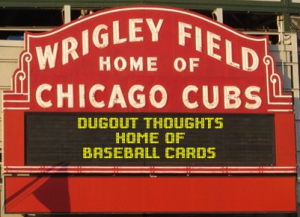
Do you mainly have a smartphone just for Topps Bunt? Whether you do or you’re just starting out and want some help, you’ve come to the right place (and if you’re still on the fence about the whole digital baseball card thing, let me rid you of your fears with Why Collect Digital Baseball Cards?) This is the ultimate Topps Bunt guide, where I will teach you how to carve out a nice collection for yourself if you’re a beginner, and if you’ve already got a solid collection, I got some tips for you too. Overall, the app is pretty straightforward, but while it’s easy to learn the basics of collecting and playing for points, there’s a lot that you basically only learn by experience. I’ll start with some pointers for the beginners reading this, so if you feel like you don’t need that feel free to skip ahead. Otherwise, hop in the dugout and learn the basics of Bunt!
UPDATE: Topps Bunt has undergone some big changes for 2016. The core app is the same, so everything here should still mostly apply, but scroll down to the bottom for a detailed description of the new changes!
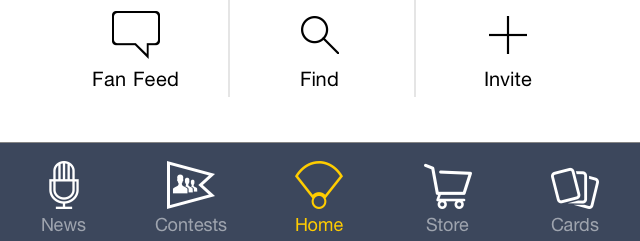
 Let’s start with the bottom of your screen, from left to right! This is your main navigation throughout the app. News (renamed Info in 2016) doesn’t seem super relevant to the app experience, but it’s very helpful to look at least once a day. Among other things, News (now Info) tells you about what cards you can get in the newest packs, upcoming contests, probable starting pitchers to help you in the contests, a few tips and general Bunt news. If you keep track of this tab, you’ll never miss a chance to snag that card you really want.
Let’s start with the bottom of your screen, from left to right! This is your main navigation throughout the app. News (renamed Info in 2016) doesn’t seem super relevant to the app experience, but it’s very helpful to look at least once a day. Among other things, News (now Info) tells you about what cards you can get in the newest packs, upcoming contests, probable starting pitchers to help you in the contests, a few tips and general Bunt news. If you keep track of this tab, you’ll never miss a chance to snag that card you really want.
 Next up is the Contests tab, which is a points player’s home. Speaking of which, a points player is someone who is most interested in scoring points in contests while a collector is someone who wants the rarest card. Knowing the difference between the two can be useful when you’re trading with someone. Anyways, the Contests tab is split into contests you can join, contests you’ve joined that are starting soon, contests you’ve joined that are in progress, and previous contests you’ve joined. When looking for a contest to join, note the entry fee which is on the right side. Some are free, but some can be pricier, generally because they have better prizes.
Next up is the Contests tab, which is a points player’s home. Speaking of which, a points player is someone who is most interested in scoring points in contests while a collector is someone who wants the rarest card. Knowing the difference between the two can be useful when you’re trading with someone. Anyways, the Contests tab is split into contests you can join, contests you’ve joined that are starting soon, contests you’ve joined that are in progress, and previous contests you’ve joined. When looking for a contest to join, note the entry fee which is on the right side. Some are free, but some can be pricier, generally because they have better prizes.
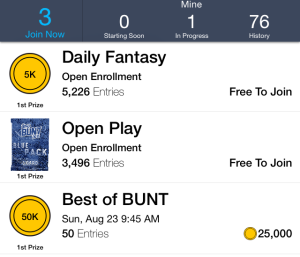
Click on a contest and you can see the prizes, your eligible cards, and the games which will count towards that contest. Some contests require you to make decks of roughly 50-100 cards, while others let you choose from as many as you have. When you’re starting out, even if you have just 9 cards (the max amount of cards you can have in play), you might as well join some free contests and see what happens. I’ll talk more about contest strategy later, but I’ll just stop with the basics for now.
 Fittingly, the middle tab is your Home tab. From here you can see how many coins you have, any pending trades, your trader rating, any ongoing contests, the awards you’ve earned, quick stats on your card collection, upcoming MLB games and the social component including the fan feed, which is where you’ll make trades. The fan feed is your best friend for reaching out to other people playing Bunt, and it’s by far your best bet for making trades. I’ll say more on trades later. Anyways, it’s always a good idea to check out your Home tab to see if anyone has made any trade offers for your cards. The top left corner of the tab brings up the bulletin, which you should keep up with in case there are free cards up for grabs, as there sometimes are. The top right corner of this tab brings up options, like the tutorial and settings.
Fittingly, the middle tab is your Home tab. From here you can see how many coins you have, any pending trades, your trader rating, any ongoing contests, the awards you’ve earned, quick stats on your card collection, upcoming MLB games and the social component including the fan feed, which is where you’ll make trades. The fan feed is your best friend for reaching out to other people playing Bunt, and it’s by far your best bet for making trades. I’ll say more on trades later. Anyways, it’s always a good idea to check out your Home tab to see if anyone has made any trade offers for your cards. The top left corner of the tab brings up the bulletin, which you should keep up with in case there are free cards up for grabs, as there sometimes are. The top right corner of this tab brings up options, like the tutorial and settings.
 The Store is where you buy packs or coins. They give you 5,000 coins a day just for checking into the app, and 50,000 for every week you keep up your streak of checking in (by the way, the Bunt day resets at 6 AM ET/5 AM CT/ 3 AM PST.) You can definitely buy some nice packs and build a solid collection with these daily coin offerings. When buying packs, check out what kind of cards you can get from it (which the News (now Info) tab can help you figure out), along with the odds of getting the rare card you really want. Some packs are 5,000 coins, one is only 1,500, and they can get up to 75,000, depending on the cards inside and the odds of getting rare ones.
The Store is where you buy packs or coins. They give you 5,000 coins a day just for checking into the app, and 50,000 for every week you keep up your streak of checking in (by the way, the Bunt day resets at 6 AM ET/5 AM CT/ 3 AM PST.) You can definitely buy some nice packs and build a solid collection with these daily coin offerings. When buying packs, check out what kind of cards you can get from it (which the News (now Info) tab can help you figure out), along with the odds of getting the rare card you really want. Some packs are 5,000 coins, one is only 1,500, and they can get up to 75,000, depending on the cards inside and the odds of getting rare ones.
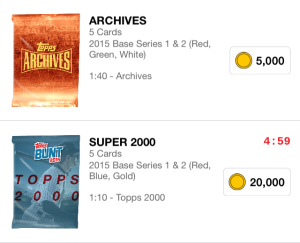
Just a small sampling of the ever-changing Bunt Store.
From the Store you can tap “Coins” on the top right corner(while the top left corner shows the amount of coins you have) to enter the coin store. Here you can buy coin bundles, from cheap ones to more pricey ones. You don’t need to buy the most expensive one, but it’s not really worth it to get the cheapest ones if you decide to spend some money. From the coin store you can tap “Free!” on the top right corner to get free coins by completing tasks like downloading apps and watching videos. You can get a lot of coins which translate to a lot of cool cards before spending a dime in Bunt.
 Finally, saving the best for last, we end with the Cards tab. This is the shoebox, because it holds your collection. From this tab you can scroll through your cards sorted in many different ways, whether you prefer by parallel, by team, by average points scored or a few other sorting options. You can search through your cards, and you can even sort by date acquired. That last one is helpful in case you ever open a pack and accidentally slide up instead of right, so that you don’t see the rest of the cards, which happens to the best of us. Anyways, the Cards tab is the collector’s favorite, because it never gets old looking through all the cards you’ve managed to pick up.
Finally, saving the best for last, we end with the Cards tab. This is the shoebox, because it holds your collection. From this tab you can scroll through your cards sorted in many different ways, whether you prefer by parallel, by team, by average points scored or a few other sorting options. You can search through your cards, and you can even sort by date acquired. That last one is helpful in case you ever open a pack and accidentally slide up instead of right, so that you don’t see the rest of the cards, which happens to the best of us. Anyways, the Cards tab is the collector’s favorite, because it never gets old looking through all the cards you’ve managed to pick up.

Start reading here if you skipped the basics.
This concludes the section of this guide which covers the basics, as now you know how to navigate around the app. Let’s dive in to some of these topics, now, so that you can get on the road to having a collection anyone would be proud of.
The first thing I’ll expand on is Contests. Again, you should be entering at least a free contest every day you start playing, so you can start getting used to it and getting some wins. Bunt has a solid little tutorial on how to play cards, but it’s a little confusing. Anyways, once joining a contest, you’ll either have to trim your playable cards by making a deck, or you’ll be able to play any active player in your collection. From there, you set your lineup of 9 players, which in most contests does not require every position to be filled.
 The main thing to know about Bunt contests is that starting pitchers are almost always who you should be playing (as you can see by the fact that they dominate my highest-scoring card ranks.) Since there’s a short delay between MLB games and Bunt, you can watch a game and put in a player immediately after they hit a home run to get those points. It’s hard to watch so many games at once every day, though, so your best bet is putting your starting pitchers in to rack up passive points. Before making a deck or playing cards, go check the probable pitchers for the next games on MLB At Bat or something so that you know who to play. Once the games are getting later and starting pitchers are out, you can put in some position players and hope for some home runs or something. If you’re watching MLB.TV and you have a card of a player who just hit a home run, you better go put them in for the points to score and then you can put back whoever you just bumped out once the points are in.
The main thing to know about Bunt contests is that starting pitchers are almost always who you should be playing (as you can see by the fact that they dominate my highest-scoring card ranks.) Since there’s a short delay between MLB games and Bunt, you can watch a game and put in a player immediately after they hit a home run to get those points. It’s hard to watch so many games at once every day, though, so your best bet is putting your starting pitchers in to rack up passive points. Before making a deck or playing cards, go check the probable pitchers for the next games on MLB At Bat or something so that you know who to play. Once the games are getting later and starting pitchers are out, you can put in some position players and hope for some home runs or something. If you’re watching MLB.TV and you have a card of a player who just hit a home run, you better go put them in for the points to score and then you can put back whoever you just bumped out once the points are in.
All base cards are not made equally, thanks to the parallel system of White then Green then Red then Blue then Gold. This translates to a 1x, 1. 2x, 1.5x, 1.7x and 2x scoring multiplier, respectively. So a Mike Trout Gold card will score twice as many points as a Mike Trout White card will when Mike Trout hits a home run (as he has been known to do.) Keep this in mind when you’re playing your cards, although a White Clayton Kershaw will probably still do better than a Gold mediocre starting pitcher’s card. Besides that, Bunt tells you your highest scoring cards so it shouldn’t be too hard to figure out your lineup. Just make sure whoever you put in is playing that day, especially if it’s a starting pitcher.
 The next thing you need to know about is Trading, which is the core of Topps Bunt. If you’re just starting out, you might think blind trades are the way to go, because they’re kind of the default in your Home tab. Blind trades are just trades that you make from the Home tab by pressing “New Trade”, because you set the card you want and the cards you’ll give up without seeing the other player’s cards. This means that they might already have the cards you want to trade, so you could just be wasting your time. If you have to blind trade because you can’t find a card on the fan feed, be ready to put up some nice cards in return, and include a message with the trade that says it’s a blind trade, so they know you couldn’t see their cards. Friendlier traders will deal with blind trades by countering, but many people ignore them all together.
The next thing you need to know about is Trading, which is the core of Topps Bunt. If you’re just starting out, you might think blind trades are the way to go, because they’re kind of the default in your Home tab. Blind trades are just trades that you make from the Home tab by pressing “New Trade”, because you set the card you want and the cards you’ll give up without seeing the other player’s cards. This means that they might already have the cards you want to trade, so you could just be wasting your time. If you have to blind trade because you can’t find a card on the fan feed, be ready to put up some nice cards in return, and include a message with the trade that says it’s a blind trade, so they know you couldn’t see their cards. Friendlier traders will deal with blind trades by countering, but many people ignore them all together.
 The fan feed is where the magic happens, even though it just looks like a basic message board. This is where people post the cards they’re willing to trade and the cards they’re looking for. Essential to navigating the fan feed is the knowledge that FT means For Trade, and LF means Looking For. Also, Sig means signature and people will often refer to sets by their initials (for example, Play Hard would be PH.) Sometimes people say “dupes for dupes”, which means they want to swap their duplicates of cards you don’t have for your duplicates of cards they don’t have of roughly equal value. People use color emojis for base parallels, particularly when offering deals like “take 3 of my blues and leave 1 of your golds.” It’s mostly common sense, but it can look overwhelming at first glance. Once you start posting on the fan feed, feel free to post about every minute or so a few different times so that your post isn’t buried under all the others. Don’t overdo it, but luckily the app stops you from reposting if its been less than 30 seconds, so you should be fine.
The fan feed is where the magic happens, even though it just looks like a basic message board. This is where people post the cards they’re willing to trade and the cards they’re looking for. Essential to navigating the fan feed is the knowledge that FT means For Trade, and LF means Looking For. Also, Sig means signature and people will often refer to sets by their initials (for example, Play Hard would be PH.) Sometimes people say “dupes for dupes”, which means they want to swap their duplicates of cards you don’t have for your duplicates of cards they don’t have of roughly equal value. People use color emojis for base parallels, particularly when offering deals like “take 3 of my blues and leave 1 of your golds.” It’s mostly common sense, but it can look overwhelming at first glance. Once you start posting on the fan feed, feel free to post about every minute or so a few different times so that your post isn’t buried under all the others. Don’t overdo it, but luckily the app stops you from reposting if its been less than 30 seconds, so you should be fine.
If you see someone you want to trade with, tap their profile and offer a trade. If you have a card someone wants you can ask for a lot because they can always counter, just don’t overdo it. People often instantly decline offers they think are insulting. If you’re trying to get a rare card, feel free to counter as much as you want while still offering a reasonable deal. Finally, it’s customary to rate 5 stars after completing a trade if the experience was pleasant. It takes a while to get used to figuring out relative card values, but you’ll figure it out. Also, sometimes if you post on the fan feed that you’re new, people will help you out with your collection. If you feel like you had a great trading experience with someone, feel free to add them as a friend and tell them so they can add you back. That way you can see a friend feed filled with offers from people you trust more. If you have any other questions about trading, or anything else, feel free to drop them in the comments.
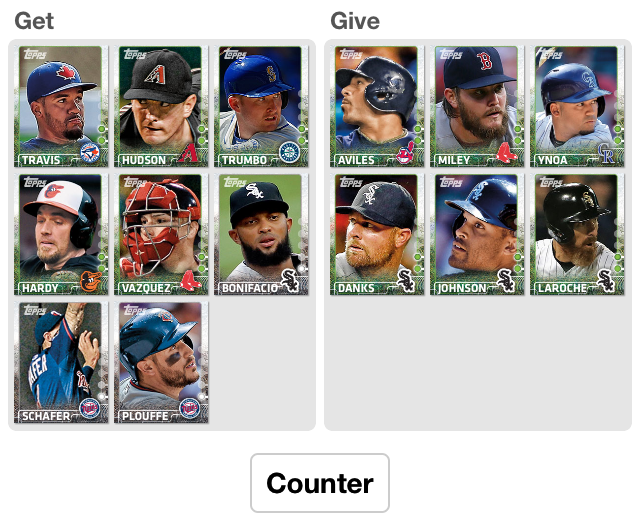
In this case, I was offered 5 greens and 3 whites for 6 greens. Since 3 whites are roughly equal to 1 green, this is regarded as a fair trade. This is also a typical trade involving duplicates.
Let me give you a quick exchange rate for base cards while I’m at it. If base cards are roughly equal in point-scoring, people will exchange like colors 1-to-1. You can also generally expect people to want 3 whites for 1 green, 3 greens for 1 red, 3 reds for 1 blue, and 3 blues for 1 gold (especially when you’re dealing with duplicates.) This also means that you can probably get 1 gold for 3 reds, unless the gold is Madison Bumgarner and you’re offering some bench-riding reds. If you stick with these rates when trading for base cards, people will usually respect your offer and counter even if they don’t like your offer, rather than outright declining.
Keep in mind that not all inserts are created equal, either. Some cards can look equally cool, but it all comes down to card count. A card which only has 150 copies floating around is much more valuable than a card which has 10,000 copies floating around. Award cards are also more valuable than their counts may indicate, since the owner had to complete some task (usually collecting a full set) before they could get that card. Just don’t expect all cards to be objectively valuable based on card count, age, or anything else, since all sorts of factors can go into someone deciding to accept or decline a trade.

Finally, let me just tell you a little bit about Coins and how to make the most of them. Again, you get 5,000 free coins a day and 50,000 every week that you’ve been checking in daily, so you definitely have some fun money without needing to open your real wallet. When you’re starting out, you’ll want to invest in Deck Builders. The 10,000 coin one is a great purchase very early on, when you need all the cards you can get, because it’s 50 cards but they’re all White. This is fine to start with, and you can buy it on your 2nd day if you don’t spend your free coins that first day. The 75,000 deck builder is great to save up for if you really want to get some Gold cards quick, because you’re guaranteed 1 Gold card along with 5 Blues (though in my experience you usually get a few more of each.)
Speaking of free coins, you can also get more free coins than the daily allowance Topps gives you. By simply downloading apps, doing some short surveys or even just watching videos you can rack up a good amount of free coins. Once you’ve done a bunch, you’ll have to wait for more offers you can do to show up, but when you just start there’s a lot of free coins waiting for you. You can also complete offers that aren’t free, like buying something or subscribing to something while getting coins in exchange. You often get a better deal here than in the coin store, along with coming away with an extra product, so even if you want to spend money you should check out the free coins.

My personal pride.
Once you have a nice collection of base cards for contest, you might want some more unique cards. For example, I seriously wanted a signature card early on, because I thought (and still think) that they’re the coolest cards in the game. I started saving my coins and stopped buying packs except for packs that could get me signatures. Since they don’t pop up constantly, you can just sit on your coins, collecting more every day, until you can spend them all trying to get that signature from that pack. Whether you’re looking for a sig or otherwise, only spend your money on packs that can give you the type on insert you really want. By the way — signature (and other rare card) packs often come in a cheap version and an expensive version. If you can afford it, go for the expensive ones because the odds are better than buying an equivalent-costing amount of the cheaper packs. Anyways, once you get that first pride for your collection, you can go back to trying to get generally cool cards without being so focused. Also, make sure you lock it so that no one bothers you with trade offers you won’t accept.
Topps Bunt 2016 Upgrade:
The 2016 Major-League season is coming up folks! With it, Topps Bunt has undergone some changes. First of all, you get 10,000 daily coins now (along with 100 experience daily… see below for more on the new experience system)! For your weekly reward, you get 25,000 coins (and 500 experience). That’s an exciting change, but much bigger changes have come to Bunt for the 2016 season.
There is now an experience system, equipment cards, an exchange system and FIVE new card parallels! I don’t fully understand these things yet myself, but let me try to break it down for you.

The new experience system and card exchange on display.
The experience system tracks pretty much everything you do in Bunt, from opening packs to placing in contests to exchanging cards. This seems like a fun way to track your progress, along with a way to get rewards every time you level up!
Equipment cards include cleats, gloves, helmets, batting gloves, baseball bats, rosin bags, hats and baseballs. These come in seven different parallels, and are used to exchange cards.
The exchange system is probably the biggest change to Bunt for 2016. The basic idea is that you can use duplicates of base cards and equipment cards to upgrade a base card’s parallel. For example, if you had two blue Bryce Harpers along with the appropriate orange parallel equipment cards (cleats, glove, helmet, batting gloves, and baseball bat for a position player, cleats, gloves, rosin bags, hats and baseballs for a pitcher), you could exchange all seven cards for an orange Bryce Harper (the next parallel up).
By the way, there are now five new card parallels! The order for 2016 is, from lowest to highest:
- White
- Green
- Red
- Blue
- Orange
- Teal
- Purple
- Black
- Silver
- Gold
That about covers the changes to Topps Bunt for 2016, but if you’re confused check out the Info tab (formerly the News tab) for detailed updates. If you’re still confused, feel free to comment here or hit me up on Bunt and I’ll try to help you out.
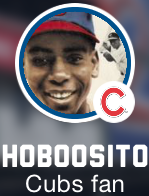 This concludes the ultimate Topps Bunt guide. I hope that you learned something reading through here, no matter your experience level. Just remember that at the end of the day, Topps Bunt is a beautiful digital translation of our favorite hobby, and we can all help each other collect some great cards. Hit me up on the app @ HoboOsito and we can make some trades. If you’re just starting, I’ll probably even help you out with some free cards. If you have any questions or suggestions for other things I should cover, let me know in the comments so I can make this guide as useful as it can be for Bunt users. I know this guide isn’t comprehensive or anything, but I figure it’s a good start and I’d love to build it up into something great. Happy pack-opening/collecting/trading/free-coin-getting!
This concludes the ultimate Topps Bunt guide. I hope that you learned something reading through here, no matter your experience level. Just remember that at the end of the day, Topps Bunt is a beautiful digital translation of our favorite hobby, and we can all help each other collect some great cards. Hit me up on the app @ HoboOsito and we can make some trades. If you’re just starting, I’ll probably even help you out with some free cards. If you have any questions or suggestions for other things I should cover, let me know in the comments so I can make this guide as useful as it can be for Bunt users. I know this guide isn’t comprehensive or anything, but I figure it’s a good start and I’d love to build it up into something great. Happy pack-opening/collecting/trading/free-coin-getting!
For more on other mobile games and video games from this author, check out My Dpad.

Love your page. It is very helpful. Topps Bunt is a wonderful app.; but it does not do well in instructions on how to play. I do have a question. You suggested trading 3 to 1 for a card of the next color level. Should a person offer three cards with the same season pts. as the card he wants or should he offer three cards that add up to the season points of the cards he wants. For example, white 3000 pts + white 3000 pts + white 3000 pts = green 3000 pts or white 1000 pts + white 1000 pts + white 1000 points = green 3000 pts.
Also, are pitcher cards worth as much as batter cards of the same pts.
Thank you
Hey Greg, sorry for the late response. This is a great question, and I wish I could give you a better answer but it just depends on the person you’re trading with. However, it can seem insulting to offer 3 mediocre white cards for 1 great green card. To stay on the safe side, it’s a good idea to offer players of a similar caliber to the one you’re trading for, though the points don’t have to exactly add up.
As for your question about pitchers and batters of the same points, pitchers are still valued higher. This is because you can pretty much count on a good starting pitcher having a good game on any day that he’s starting, while it’s harder to predict on which given days a hitter will do well, since he starts every day.
Great questions and thanks for reading Greg! Hope you’re enjoying Topps Bunt, and glad to hear this article made it a little easier.
Added you as a friend on bunt 18. If you want to add me, AZTIGER98. Love your site. Been very helpful.